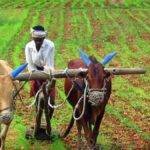Main Points In Hindi (मुख्य बातें – हिंदी में)
-
नॉर्थ डकोटा का कृषि परिदृश्य: नॉर्थ डकोटा विशाल खेतों और मेहनती कृषकों का घर है, जिसमें खेती के लिए उपयुक्त रोलिंग मैदानों का प्रचुरता है।
-
कृषि भूमि वितरण: राज्य में परीक्षित काउंटियों में विलियम्स, माउंटरेल, वार्ड और मैकेंज़ी काउंटियां शामिल हैं, जो कृषि भूमि के विभिन्न प्रतिशतों के साथ शीर्ष स्थानों पर हैं।
-
मुख्य फसलें: कृषि में प्रमुख फसलें जैसे वसंत गेहूं, देशी घास, और अन्य अनाज शामिल हैं, जिनमें प्रत्येक काउंटी में उनके अनुसार भूमि का विशेष उपयोग है।
-
मैकेंज़ी काउंटी की प्रमुखता: मैकेंज़ी कounty सबसे बड़ी कृषि भूमि वाला क्षेत्र है, जिसमें 1,527,063 एकड़ कृषि भूमि है, जो राज्य की कुल कृषि भूमि का 4.4% है।
- स्थानीय कृषि का महत्व: यह लेख सुझाव देता है कि जब हम रोटी या पास्ता का आनंद लेते हैं, तो हमें इन काउंटियों की योगदान और कृषि जीवन की विशालता को ध्यान में रखना चाहिए।
Main Points In English(मुख्य बातें – अंग्रेज़ी में)
Here are the main points from the text about North Dakota’s agricultural landscape:
-
Hardworking Farmers: North Dakota is known for its vast farmlands and hardworking farmers, particularly in the farming sector, which plays a significant role in the state’s economy.
-
Major Agricultural Counties: The article highlights the top four counties in North Dakota by agricultural land, with a focus on how these counties contribute to the state’s crop production and farming efficacy.
-
Land Use Statistics:
- Williams County has 903,754 acres of agricultural land, primarily known for its durum wheat.
- Montrail County occupies 933,521 acres and is noted for its reliance on native grass.
- Ward County matches Montrail’s acreage and is recognized for its production of hard red spring wheat.
- McKenzie County is the largest with 1,527,063 acres, predominantly growing native grass.
-
Impact of Agriculture: The text emphasizes the significance of these counties in contributing to North Dakota’s reputation as an agricultural powerhouse, touching on the diverse crops they produce.
- Culinary Connection: The article concludes by connecting the agricultural output to everyday food items such as bread and pasta, encouraging readers to appreciate the roots of their food.


Complete News In Hindi(पूरी खबर – हिंदी में)
जब आप नॉर्थ डकोटा के बारे में सोचते हैं, तो शायद आपके मन में विशाल खेतों, ट्रैक्टरों और मेहनती किसानों का ख्याल आता है। और वास्तविकता यह है कि नॉर्थ डकोटा देश के सबसे मेहनती किसानों का घर है। यहाँ की रोलिंग मैदान और उपजाऊ जमीन खेती के लिए एकदम उपयुक्त हैं। हाल ही में किए गए एक विश्लेषण में नॉर्थ डकोटा के 25 सबसे अधिक कृषि भूमि वाले काउंटियों की रैंकिंग की गई, जिसमें पश्चिमी नॉर्थ डकोटा ने प्रमुखता से भाग लिया।
प्रमुख काउंटियाँ और उनका कृषि योगदान
-
विलियम्स काउंटी:
- कृषि भूमि: 903,754 एकड़ (राज्य की कुल कृषि भूमि का 2.6%)
- खेतों की संख्या: 1,950
- प्रमुख उत्पाद: कठोर एंबर ड्यूरम वसंत गेहूं, जो 244,045 एकड़ पर उगता है, यानी काउंटी की कृषि भूमि का 27%।
-
माउंट्रेल काउंटी:
- कृषि भूमि: 933,521 एकड़ (राज्य की कुल का 2.7%)
- खेतों की संख्या: 2,045
- प्रमुख उत्पाद: देशी घास, जो 324,842 एकड़ में फैली हुई है, यह काउंटी के खेतों का 34.8% है।
-
वार्ड काउंटी:
- कृषि भूमि: 933,581 एकड़ (राज्य की कृषि भूमि का 2.7%)
- खेतों की संख्या: 2,489
- प्रमुख उत्पाद: कठोर लाल वसंत गेहूं, 263,691 एकड़ में उगता है, जो काउंटी की कृषि भूमि का 28.2% है।
- मैकेंजी काउंटी:
- कृषि भूमि: 1,527,063 एकड़ (राज्य की कुल क्षेत्रफल का 4.4%)
- खेतों की संख्या: 1,392
- प्रमुख उत्पाद: देशी घास, 1,009,910 एकड़ में फैली हुई है, जो काउंटी के खेतों का 66.1% है।
इन काउंटियों का योगदान न केवल नॉर्थ डकोटा की कृषि अर्थव्यवस्था में महत्वपूर्ण है, बल्कि यह भी दर्शाता है कि कैसे यह क्षेत्र देश के कृषि उत्पादन में एक प्रमुख भूमिका निभाता है।
तो अगली बार जब आप रोटी या पास्ता का आनंद लें, तो नॉर्थ डकोटा के इन काउंटियों की याद रखें, जहाँ कृषि जीवन का एक बड़ा हिस्सा है।


Complete News In English(पूरी खबर – अंग्रेज़ी में)
When you think of North Dakota, images of vast fields, tractors, and hardworking individuals in flannel likely come to mind. This perception is accurate, as North Dakota is home to some of the country’s most diligent farmers, particularly in the realm of agriculture. The state’s rolling plains offer miles of fertile land just waiting to be cultivated. If farmland were a person, it would certainly need a pair of oversized jeans and a comfortable hat, because there’s a lot of ground to cover!
Recently, Stacker.com analyzed data to rank the top 25 counties in North Dakota based on the amount of agricultural land. Unsurprisingly, western North Dakota made a significant impact on the rankings. Let’s take a closer look at the top four counties in this area and their contributions to North Dakota’s agricultural prowess.
9th: Williams County
Located in western North Dakota, Williams County boasts 903,754 acres of agricultural land, accounting for 2.6% of the state’s total. The county is home to 1,950 farms, with durum wheat being its primary crop—this type of wheat is literally the bread and butter of the area. Durum wheat occupies 244,045 acres or 27% of the county’s agricultural land. So, if you are a fan of pasta, this is where your dreams of durum come true!
8th: Mountrail County
Next to Williams County, Mountrail County is also a strong contender, with 933,521 acres (2.7% of the state’s total). It houses 2,045 farms and relies heavily on native grasslands, which occupy 324,842 acres or 34.8% of the farmland here. You could say Mountrail is where the grass is truly green!
7th: Ward County
Ward County matches Mountrail in acreage, with 933,581 acres (also 2.7% of North Dakota’s agricultural land) but stands out with 2,489 farms. The county is celebrated for its hard red spring wheat, which covers 263,691 acres, representing 28.2% of the agricultural land. Wheat lovers can rejoice here!
1st: McKenzie County
Drumroll, please! McKenzie County not only ranks first in the western region but is the top agricultural county in the entire state, with a whopping 1,527,063 acres of farmland—4.4% of the state’s total area. Its 1,392 farms primarily cultivate native grass, covering 1,009,910 acres or 66.1% of the farmland in this county. When it comes to "planting" on prairie land, McKenzie truly leads the way!
So, the next time you enjoy bread or pasta, remember these counties in western North Dakota—where agricultural life flourishes, and the land is even bigger.








